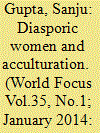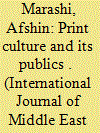| Srl | Item |
| 1 |
ID:
128182


|
|
|
|
|
| Publication |
2014.
|
| Summary/Abstract |
Diasporas are the human face of the globalization process. The contemporary importance of Diasporas can be related to the seemingly contradictory historical processes of consolidation of national cultural identities and large international migrations. Though the phenomenon of migration is as old as the existence of humanity, international migration on a large scale started during colonial times. Labour demand, political conflicts, technological changes and trade and commerce together, contribute to international migration becoming one the most important determinant of modern global change.
This paper attempts to explain the cross cultural conflicts, trauma, isolation, aspirations and dilemmas of the Indian Women immigrants in Jhumpa Lahiri's The Namesake , especially Aashima Ganguly, who find herself in between the native culture and host culture and her trishanku experience of being neither in Calcutta nor in America which is at the very centre of diasporic trauma. Ashima is a true representative of the majority of women expatriates who are reluctant to change or adapt to the culture of the host country. But still she sacrifices all her comforts for the sake of her family and like the typical traditional Indian women; her life revolves around her husband and children.
|
|
|
|
|
|
|
|
|
|
|
|
|
|
|
|
| 2 |
ID:
139902


|
|
|
|
|
| Summary/Abstract |
This article investigates the evolution of print culture and commerce in Tehran during the first half of the 20th century. The first section examines technological changes that facilitated the commercialization of texts and then details the history of early print entrepreneurs in the Tehran bazaar. The second section examines the expansion of the book trade between the 1920s and 1940s, tracing the emergence of modern bookstores in a rapidly changing Tehran. I argue that patterns of change in print commerce between 1900 and 1950 contributed to the emergence of mass culture by midcentury. This new mass culture involved the social and political empowerment of a diversity of new reading publics in the city, and enabled the emergence of new forms of popular politics.
|
|
|
|
|
|
|
|
|
|
|
|
|
|
|
|
| 3 |
ID:
128053


|
|
|
|
|
| Publication |
2014.
|
| Summary/Abstract |
Technological change has often been presented as a readily accepted means by which long-term greenhouse gas (GHG) emission reductions can be achieved. Cities are the future centers of economic growth, with the global population becoming predominantly urban; hence, increases or reductions of GHG emissions are tied to their energy strategies. This research examines the likelihood of a developed world city (the Greater Toronto Area) achieving an 80% reduction in GHG emissions through policy-enabled technological change.
Emissions are examined from 3 major sources: light duty passenger vehicles, residential buildings and commercial/institutional buildings. Logistic diffusion curves are applied for the adoption of alternative vehicle technologies, building retrofits and high performance new building construction. This research devises high, low and business-as-usual estimates of future technological adoption and finds that even aggressive scenarios are not sufficient to achieve an 80% reduction in GHG emissions by 2050. This further highlights the challenges faced in maintaining a relatively stable climate. Urban policy makers must consider that the longer the lag before this transition occurs, the greater the share of GHG emissions mitigation that must addressed through behavioural change in order to meet the 2050 target, which likely poses greater political challenges.
|
|
|
|
|
|
|
|
|
|
|
|
|
|
|
|